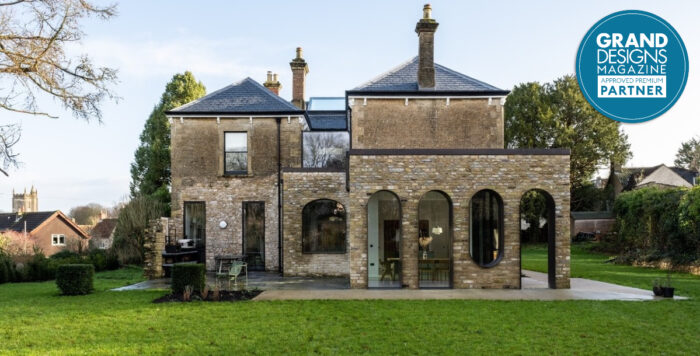Guide to modern bathroom surfaces
Fabulous and functional, treat your bathroom to sleek surfaces for a hit of designer style
Well-chosen suites can only go so far in creating a luxury bathroom, but choosing an on-trend bathroom surface can be an easy way to elevate your scheme.
‘Gone are the days when bathrooms were clinical, white spaces,’ says Dan Cook, principal development designer at CP Hart. ‘Bathroom design now is about individualisation with colours, prints and mixed materials. Surfaces not usually seen in the bathroom, such as wood, are proving popular now, too.’

Photo: Rory Gardiner
Raw materials
Wood and wood-look surfaces bring a natural feel into the space. Raw solid timber can warp with humidity, but there are convincing alternatives. Veneers and engineered wood are more stable as they’re constructed with a slice of timber on top, or you could opt for porcelain tiles and laminate panels.
‘Light wooden furniture and surfaces are going to be a big trend,’ predicts Robin Levien, international designer at Ideal Standard. ‘Thanks to treatments and finishes, woods that once wouldn’t have survived in damp environments now can. Great for adding a rustic theme, think less polish, more rough-hewn finishes.’ Engineered wood and wood-look porcelain are usually compatible with underfloor heating (UFH).
Concrete is ideal for adding an industrial edge and can be used across walls or floors. It can be tricky to pour but the look can be achieved with cement-effect tiles or quartz composites. Cement and concrete are usually UFH-compatible but make sure to check.
Plaster finishes, like tadelakt, can be coloured any shade, work in large areas and are water-resistant. ‘Be careful when using it in areas where water may sit on the surface, such as the floor of a shower, as standing water can affect the finish,’ advises Sophie Elborne, creative director at Kitesgrove Design. ‘It looks great paired with patterned tiles and can be retouched. Ask the supplier what substrate they recommend, as well as what to use to seal it with.’

Photo: Rory Gardiner
Luxury design
Marble has long been considered as the go-to finish for a sense of grandeur thanks to its smooth surface and attractive veining. Depending on the variety – the need for bespoke manufacture and whether it’s bookmatched or slip-matched – it can be pricey, so an affordable way of using it is often as tiles or mosaics.
‘Marble vanity tops and bath surrounds will require sealing,’ says Rebecca Cherrington, head of projects at Lapicida. ‘This will protect from stains but it can’t stop etching from contact with acidic substances, where the marble is slightly eaten away. All natural stones are susceptible to acid etching, but the darker and more polished a marble, the more it will show. Ask your supplier which finish will be best for your use.’
Porcelain and ceramic marble-look tiles, digitally printed to mimic the natural veining, are affordable alternatives. Plus, robust marblestyle porcelain and solid surfaces can be made in sheets that may not be as costly and minimise the need for joins.
Natural finishes Stone, including granite, travertine and slate, is more hardwearing than marble and water-resistant, but as it’s porous it will require sealing and maintenance with a specialist pH-neutral cleaner.

Photo: Rory Gardiner
Available in polished and honed finishes, more opulent varieties are becoming mainstream. Stone is a great choice for flooring thanks to its natural slip-resistance (unless highly polished) and UFH compatibility.
Non-porous quartz/stone resin composites and solid surfaces often replicate natural stones, such as marble and granite, but are more resistant to limescale, stains, mould and mildew, and can have seamless joins. Look for brands such as Caeserstone, Corian and Compac or unbranded options, which can be more cost-effective.
These usually require templating (unless you’re fitting an off-the-peg surface) but, once installed, should be relatively maintenance free. Gentle cleaning products are advisable to keep them looking great. Stone-look laminate is affordable and may cost as little as a third of the price.

Photo: Rory Gardiner
A choice of striking designs, shapes and stone-effect ranges have turned ceramic and porcelain tiles into on-trend options. Textured surfaces, mosaics and large formats are very popular, as are glazes and tones.
‘Ombre is now also coming into tiles,’ says Jess Piddock, inhouse interior designer at Domus. ‘There is a current trend for stronger blue hues, such as indigo and denim, as these are colours that pair well with white in a scheme.’
While porcelain and ceramic are similar, both requiring minimal maintenance and being UFH compatible, porcelain tiles are more durable, have greater resistance to water and stains, but tend to be more expensive than ceramic ones. Keep them both spotless with a soft cloth or brush and non-acidic cleaner or by steam cleaning.
For a less standard look, think about using bespoke materials. For walls, patterned, tinted or mirrored glass is ideal as it’s waterproof and reflective, so helps make a space feel bigger and lighter. A more cost-effective alternative is acrylic or laminate but be aware that these surfaces can scratch.

Photo: Rory Gardiner










